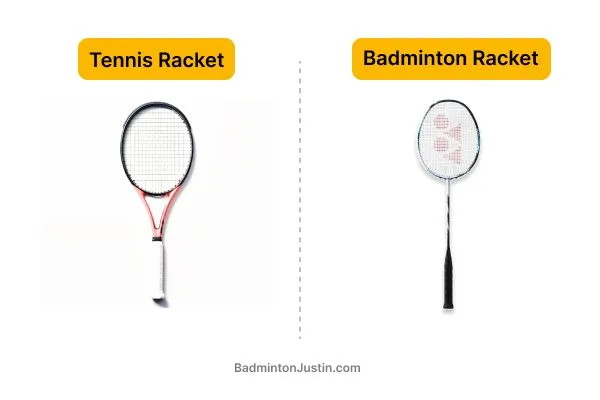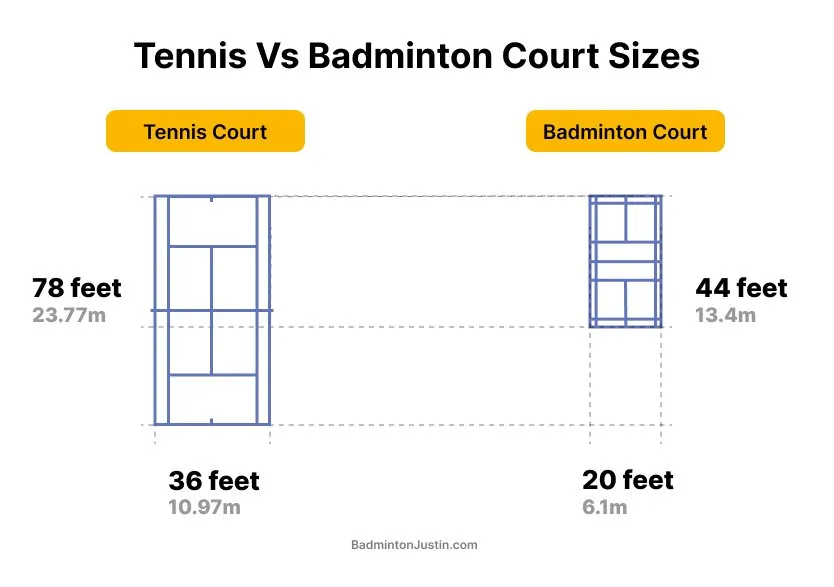
Tennis Vs. Badminton: Which Is Harder (Or Better)?
Playing tennis or badminton - which is harder (or better)?
Both sports have unique pros and cons. If you struggle to decide which sport to pursue, this post will provide the full guide on tennis vs. badminton.
Specifically, you’ll discover:
- Which sport is harder to learn
- Which sport is harder physically
- Which sport is more costly
For those that are new here, I’m Justin Ma. A professional badminton player since 8 years, play badminton since 18 years - and have won 7x US Junior National Championships.
As a quick overview:
Aspect Tennis Badminton Physical Demands High Medium Accessibility Less accessible More accessible Cost More expensive Less expensive Learning Curve Difficult Less difficult Injury risk Medium Low Summary Burns more calories, but is harder to learn and is more difficult to stick to. Expensive and higher injury risk. Burns less calories, but as such is easier to learn and more fun to play for beginners. Less expensive.Let’s dive right in:
Physical Demands
Tennis: The tennis sport requires a high level of cardiovascular endurance, strength, and agility. All things considered, it’s definitely more physically taxing than badminton.
Players need to cover a large court, often running long distances and making powerful shots that require significant upper-body strength.
Matches can last several hours, especially at higher levels, demanding sustained endurance and focus.
Badminton: While badminton might seem less intense at first glance, it is actually one of the fastest racket sports in the world.
The shuttlecock can travel at speeds exceeding 200 mph, demanding lightning-fast reflexes and explosive agility.
The court is smaller than a tennis court, but the rapid changes in direction and the need for quick, precise movements can be even more taxing. Players are constantly jumping, diving, and lunging, which provides an excellent cardiovascular workout and enhances muscle endurance and coordination.
You are also doing this with much shorter breaks and a faster pace, putting in a tough workout in a short amount of time.
Accessibility and Cost
Tennis: Tennis can be a bit more challenging in terms of accessibility.
It requires a larger playing area, and finding available courts can sometimes be difficult. Additionally, tennis equipment—rackets, balls, and proper footwear—can be relatively expensive.
The maintenance of the courts, whether grass, clay, or hard, adds another layer of complexity and cost. Your availability to play tennis is also controlled by the weather!
Badminton: Badminton, on the other hand, is more accessible and cost-effective.
A game can be played on any flat surface with a net, making it easy to set up in a backyard, gymnasium, or even indoors. Badminton rackets are generally less expensive than tennis rackets, and shuttlecocks are affordable - plastic ones are reusable.
This accessibility makes badminton an attractive option for beginners and those looking to enjoy a sport without a significant financial investment to start.
Learning Curve
Tennis: Starting off, tennis can be extremely hard for beginners.
The heavy weight of the racket, size of the court, and basic strokes can be hard to pick up for new players. Serving, in particular, can be quite challenging for beginners, requiring technique and strength to consistently execute powerful and accurate serves.
The initial learning curve can be steep, which might be discouraging for some new players.
Badminton: Badminton has a more gradual learning curve.
Beginners can quickly grasp the basics and start enjoying the game. The smaller court size and the lighter shuttlecock make it easier for new players to keep rallies going, which can be more encouraging and fun.
As skills improve, players can develop more advanced techniques and strategies, making the game progressively challenging and engaging.
Injury Risk
Tennis: Tennis requires quite extensive fitness levels. As such, tennis is harder than badminton.
It’s physical requirements include running, jumping, and hitting. Because the ball is heavier and the court larger, the injury risk can be high for older athletes (or the ones prone to injuries).
Badminton: While badminton is still physically demanding, it’s less so than tennis.
The courts are smaller, and the ball is lighter. As such, the injury risk is smaller than in tennis.
Overall, badminton offers a more approachable fitness option for individuals of all fitness levels, making it an ideal choice for those looking to improve their health with less strain on the body.
Frequently Answered Questions (FAQs) About Tennis Vs Badminton
There are a bunch of questions you might be having about choosing between tennis or badminton. Here are the most common questions I’ve answered:
What burns more calories badminton or tennis?
Tennis burns more calories than badminton. An hour of singles tennis can burn anywhere from 400 to 600 calories, depending on the intensity of the game. Badminton burns slightly less, with an hour burning anywhere from 300 to 500 calories.
What are the differences between a tennis racket vs badminton racket?
Size and Weight: Tennis rackets are generally larger and heavier compared to badminton rackets. A typical tennis racket weighs between 260-350 grams, whereas a badminton racket weighs around 80-100 grams. This means, a typical tennis racket is 3-4x heavier than a badminton racket.
Shape: Tennis rackets have an oval or teardrop-shaped head, while badminton rackets usually have an isometric (square-shaped) head to provide a larger sweet spot.
String Tension: While tennis rackets have higher string tension (40-70 lbs) compared to badminton rackets (18-30 lbs), badminton rackets have significantly higher string tension per size. The higher string tension per size in badminton rackets provides better control and accuracy for the shuttlecock.
Grip: The grip on a tennis racket is thicker and larger to accommodate the stronger swings and larger impact forces in tennis. Badminton racket grips are thinner and smaller to allow for the quick wrist movements required in badminton.
Frame Material: Both rackets are often made from high-grade materials like carbon fiber or graphite, but tennis rackets are generally more robust to withstand the heavier ball impacts.
What are the differences between a badmin court vs tennis court (size)?
A tennis court is about twice as long and wide than a badminton court.
- A tennis court measures 23.77 meters (78 feet) long and 10.97 meters (36 feet) wide for doubles.
- A badminton court measures 13.4 meters (44 feet) long and 6.1 meters (20 feet) wide for doubles.
For singles:
- A tennis court measures the same length, and 5.18 meters (17 feet) wide.
- A badminton court measures the same length, and 8.23 meters (27 feet) wide.
Additional differences are:
Aspect Badminton Court Tennis Court Size (Doubles) 13.4 meters (44 feet) long 6.1 meters (20 feet) wide 23.77 meters (78 feet) long 10.97 meters (36 feet) wide Size (Singles) 13.4 meters (44 feet) long 5.18 meters (17 feet) wide 23.77 meters (78 feet) long 8.23 meters (27 feet) wide Net Height 1.55 meters (5 feet 1 inch) at the edges 1.524 meters (5 feet) in the center 1.07 meters (3 feet 6 inches) at the posts 0.91 meters (3 feet) in the center Surface Wood, synthetic material, or rubber Provides quick movement and minimal impact Clay, grass, hardcourt, or synthetic Affects the speed and bounce of the ballWhat are the differences between a badminton net vs tennis net?
Badminton Net: The net is 1.55 meters (5 feet 1 inch) high at the edges and 1.524 meters (5 feet) high in the center. It’s 6.1 meters (20 feet) wide.
Tennis Net: The net is 1.07 meters (3 feet 6 inches) high at the posts and 0.91 meters (3 feet) high in the center. It’s 12.8 meters (42 feet) wide.
Both nets are typically made from durable synthetic materials. Tennis nets are designed to resist heavier impacts from tennis balls, while badminton nets are not as sturdy because they only need to handle the lighter shuttlecock.
Link nội dung: https://truyenhay.edu.vn/if-you-need-to-keep-fit-then-why-not-take-on-a-sport-such-as-badminton-or-tennis-a65255.html

